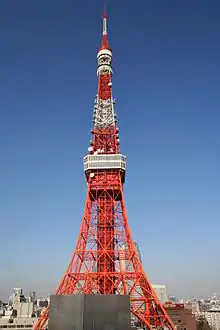1958 in Japan
Events in the year 1958 in Japan. It corresponds to Shōwa 33 (昭和33年) in the Japanese calendar.
| |||||
| Decades: |
| ||||
|---|---|---|---|---|---|
| See also: | Other events of 1958 History of Japan • Timeline • Years | ||||
Incumbents
- Emperor: Hirohito[1]
- Prime minister: Nobusuke Kishi[2]
- Chief Cabinet Secretary: Kiichi Aichi until June 12, Munenori Akagi
- Chief Justice of the Supreme Court: Kōtarō Tanaka
- President of the House of Representatives: Shūji Masutani until April 25, Nirō Hoshijima from June 11 until December 13, Ryōgorō Katō
- President of the House of Councillors: Tsuruhei Matsuno
Events

Tokyo Tower is opened to the public for the first time.
- January 26 - According to Japan Coast Guard official confirmed report, a passenger ferry Nankai Maru capsized Kii Channel, between Wakayama City to Tokushima City, total 167 persons drowned.[3]
- March 9 - The Kanmon Tunnel opens, connecting Honshu and Kyushu by road for the first time.
- April Unknown date – Ohyama Blow Manufacturing, as predecessor of Iris Ohyama was founded.
- May 2 - Nagasaki Flag incident - Ultra-nationalists pull down a Chinese flag hanging outside an exhibition of postage stamps in Nagasaki, freezing relations between China and Japan.[4]
- May 22 - General election of 1958 - The Liberal Democratic Party win 298 out of 467 seats.
- June 24 - According to official Japanese government confirmed report, a large scale eruption in Mount Aso, Kumamoto Prefecture, killed a total of twelve persons, and wounded 28.
- August 2 - An All Nippon Airways Douglas DC-3 plunges in the sea close to the Izu Islands, killing all 33 occupants of the aircraft.[5]
- September 27 - Typhoon Ida kills at least 1,269 in Honshu.
- October 14 - Construction of Tokyo Tower is completed.
- November 10 - According to Japan Meteorological Agency official confirmed report, a large scale erupted in Mount Asama, Gunma Prefecture, ash height maximum 8,000 meters.
- December 23 - Tokyo Tower is opened to the public for the first time, at a final cost of ¥2.8 billion ($8.4 million in 1958).[6][7]
- December 27 - National Health Care Act of 1958.
Births
- January 20 - Masuo Amada, voice actor
- January 30 - Sayuri Ishikawa, enka singer
- February 1 - Ryō Horikawa, voice actor
- March 10 - Hiroshi Yanaka, voice actor
- April 1 - Hiromi Kawakami, author and writer
- April 7 - Shinobu Adachi, voice actress
- April 12 - Hyōichi Kōno, adventurer (d. 2001)
- April 14 - Junko Sakurada, actress and singer
- April 21 - Yoshito Usui, manga artist, creator of Crayon Shin-chan (d. 2009)
- May 2 - Yasushi Akimoto, record producer, lyricist and television writer
- June 14 - Masami Yoshida, javelin thrower (d. 2000)
- June 20 - Teiyū Ichiryūsai, voice actress
- July 5 - Kyoko Terase, voice actress
- July 22 - Tatsunori Hara, professional-baseball coach and player
- August 2 - Shō Hayami, voice actor and singer
- August 15 - Chiharu Suzuka, voice actress
- September 8
- Mitsuru Miyamoto, voice actor
- Reiko Terashima, manga artist and illustrator
- October 15 - Masako Katsuki, voice actress
- October 23 - Hiroyuki Kinoshita, actor and voice actor
- November 12 - Hiromi Iwasaki, singer
- November 27 - Tetsuya Komuro, music producer and songwriter
- December 2 - Mina Asami, actress
- December 26 - Mieko Harada, actress
Date unknown
- Yoshiteru Otani, cartoonist
Deaths
- April 2 - Jōsei Toda, educator and peace activist (b. 1900)
- September 20 - Ogasawara Naganari, admiral and naval strategist (b. 1867)
See also
References
- "Hirohito | Biography, Accomplishments, & Facts". Encyclopedia Britannica. Retrieved 27 March 2019.
- Helms, Ludger (2012). Poor Leadership and Bad Governance: Reassessing Presidents and Prime Ministers in North America, Europe and Japan. Edward Elgar Publishing. p. 178. ISBN 978-0-85793-273-0.
- [:ja:南海丸遭難事故] (Japanese language edition) Retrieved date 7 January 2019.
- Ward, Rowena (July 2006). "Japanese government policy and the reality of the lives of the zanryū fujin". PORTAL: Journal of Multidisciplinary International Studies. 3 (2): 1. doi:10.5130/portal.v3i2.142. Retrieved 25 December 2014.
- "Accident description". Aviation Safety Network. Retrieved 25 December 2014.
- Fackler, Martin (30 December 2008). "Tokyo Tower goes from futuristic hope to symbol of the good old days". International Herald Tribune. Retrieved 21 January 2009.
- "Tokyo Tower vs. Super Tower: Crossed Signals?" (PDF). Colliers International. October 2005. Archived from the original (PDF) on 4 February 2010. Retrieved 21 January 2009.
This article is issued from Wikipedia. The text is licensed under Creative Commons - Attribution - Sharealike. Additional terms may apply for the media files.
